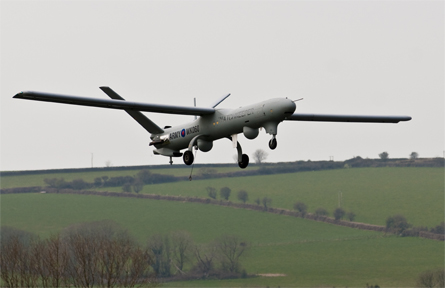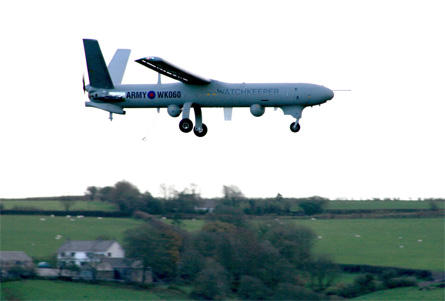The first British Army personnel selected to operate the service's new Watchkeeper tactical unmanned air vehicles will begin training on the system in May, while the first equipment is due to be deployed to Afghanistan before the end of the year.
Flight-testing activities in Israel and the UK have now exceeded 220 sorties using Watchkeeper 450 (WK450) air vehicles, a design developed from Elbit Systems' Hermes 450 for the Thales UK-led programme. Fourteen of these had been performed from the ParcAberporth unmanned system test centre in west Wales by earlier this year, the Ministry of Defence says.
 |
|---|
© Thales UK |
"We will continue flying both paths in parallel and finish trials around May," says Nick Miller, business director for intelligence, surveillance, target acquisition and reconnaissance (ISTAR) and UAV systems for Thales UK. Training activities will then begin for the first intake of Royal Artillery personnel at the army's Larkhill site in Wiltshire, before they participate in operational field trials at ParcAberporth around mid-year.
Current programme activities are centred on proving the WK450's full flight envelope, and on advancing sensor and datalink testing using production hardware in a synthetic laboratory at the Leicester manufacturing facility of Thales/Elbit joint venture U-TacS.
Flight testing using the UAV's twin electro-optical and Thales I-Master synthetic aperture radar/ground moving target indication (GMTI) payloads is also going well, says Miller, with "GMTI the real winner".
"We're building ahead of schedule," says Miller. "The first 10 air vehicles are already built, along with several ground control stations."
Following the completion of field trials, the Watchkeeper system will be involved in exercises on the Salisbury Plain training area in Wiltshire. This will for the first time see UAVs making use of a temporary segment of restricted airspace available after taking off from the MoD's nearby Boscombe Down test centre.
 |
|---|
© Thales UK |
Army operations with the WK450 will start in Afghanistan late this year, with the equipment to provide a sixth "tasking line" to provide ISTAR support for UK and coalition forces.
The new system will progressively replace the interim service provided since 2007 via an urgent operational requirement deal with Thales. Using leased Hermes 450s, the company has delivered more than 43,500 flight hours of surveillance support, with five tasking lines now in use.
"We do about 80% of the airborne ISTAR for the UK's forward operating bases," says Miller.
The current urgent operational requirement arrangement is contracted through mid-2012, with this to enable the army to make a phased transition to using its new Watchkeeper equipment. Deployed Hermes air vehicles are meanwhile about to gain a GPS-based automatic take-off and landing capability.
Source: Flight International























